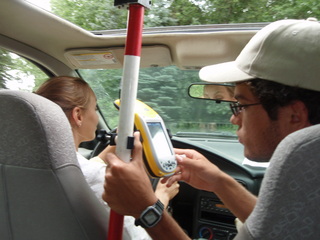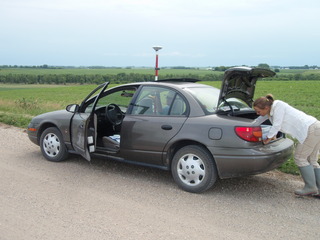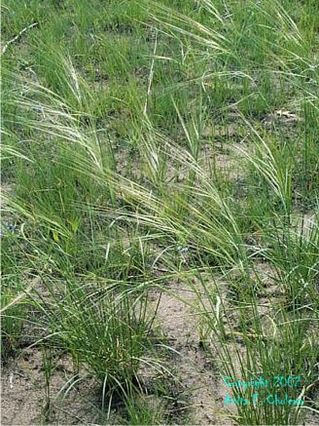|
|
So, for those of you who were wondering what Team Echinacea will be doing tomorrow, here is the field protocol for the transect searches that we will be using.
Field Protocol.doc
Any questions, please let us know!
Also, we were searching for Stipa today (a prairie grass that Dr. Ridley is planning to add to the common garden), and this is the setup we used to mark the sites with the GPS:

The antenna allowed us to get about a 9 cm margin of error when using the Trimble. And yes, that is yours truly manning the antenna, ensuring that the carrier lock is not lost. We were all ready to tell the next person who asked us what it was that we were searching for nuclear waste.

I have returned to take images of pollen as seen below. It will still be a few hours/days/more? to get the images as desired but this is a start. I am predicting some trouble to distinguish between coreopsis, helianthus, and echinacea so be ready to be distinguishing.
Attached are a protocol for pollen slides and the image of echinacea 7.1.09.ech7.1
Protocol for Pollen Slide Prep.doc
Amanda, Kate, and I have combined our protocols and I’ve included a revised equipment list.
Echinacea PONS equip list.doc
Ech combined PollComp Protocols.doc
The following people have agreed (I think) to help with this project on the mornings of July 7th and July 9th, as well as July 21st and July 23rd. If you cannot for some reason, let us know tomorrow.
Stuart, Gretel, Caroline, Amy, Daniel, Greg, Megan, Mimi, Amanda, Kate. Thanks everyone!
Also, after some discussion with Allegra about her pollination and painting needs for this week, I think that we need to either A) give up one person and therefore one remnant to help Allegra or B) have the normal 4 observations for remnants with less than 8 plants instead of doing more observations within the 3 hr pd, and have those people help Allegra when they are done early with pollinator observations/style collection or C) a combination of A&B. Thoughts?
Note: I have included the protocol in with pollinator observations and style collections because we are using the same plants for all 3. However, 3 people can do this over the course of 3 pm’s. Those who are helping so far are: Kate, Allegra (when not doing pm pollinations)
Friday we practiced catching insects for a half hour but much more practice is needed and those who were not there on friday need to be trained. I think a group training/practicing session before lift-off is imperative.
Today Daniel and Allegra helped me assess the flowering plants situation at some of the remnants we plan on using. We flagged flowering plants at: Riley (5),YOH (3), NRRX (4), LC (8), Steven’s appch (3). Some of these sites had plants that seemed likely to flower by Tuesday so we flagged those plants as well.We randomly selected 8 plants for LC since there were 17 that were either flowering or seemed very likely to flower by Tuesday. There was only 1 plant flowering at NWLF so that site has been eliminated. We also noted co-flowering species for each remnant. Tomorrow we need to finish flagging and randomly selecting plants at the 5 other remnants.
Stay tuned for July 4th picnic and kick-ass sandcastle pictures!
For some time, the powers that be on the Echinacea project have thought, “Wouldn’t it be nice to compare all we’ve learned from coneflower with another important native component of the prairie?” Well, this summer, study of habitat fragmentation and its ecological and evolutionary impacts broadens to include an additional species. And the winner is … Stipa spartea aka porcupine grass! The time is right now to collect the seed, which will be sown into the common garden later this summer.

Here’s a link to a page from the Bell Museum of Natural History about Stipa spartea.
Below, you will find the sampling protocol that Greg and I used to collect seeds from Staffenson Prairie this afternoon. Stuart may have thoughts to add and the strategy might change a bit as we run into the reality of different Stipa remnant populations. In addition to remnants, we will also be collecting seeds from roadside transects. Expect that challenge to be met later next week.
Protocol for sampling Stipa spartea in prairie remnants.doc
As promised, you can read the protocol I’ve developed for collecting pollen styles from Echinacea plants. This protocol will be joined with Mimi and Amanda’s to form one complete and very awesome experiment. You can find my protocol here:
Kate’s Proposal_1.doc
Input welcome!
-Kate
We mowed most of the CG this morning. Putting flags in went smoothly. It helped that we left many flags overwinter. We mowed according to the plan established two years ago. We started removing clippings & pulling flags that marked fl pla from 2008.
I noticed a plant I do not recognize at R46 P~903. Also, in R14 near P870 there is a patch of somethings that is starting to spread. We should determine if it’s a weed we should eliminate.
Here are some clarifications about how mfl and immfl should be filled in for heads in and past the flowering stage. Selecting status “Flowering” means that the last day of flowering is certainly 4 days away or longer. If the last day of flowering is 3 or fewer days away, then select “End of flowering.”
Status
Flowering It is not necessary to fill in mfl, ffl, or immfl. (mfl and Immfl are presumed to be well over 11).
End of flowering Fill in mfl and immfl! (Both may 11.)
Last day of flowering Fill in mfl and immfl! (immfl should be zero.)
Done flowering Fill in mfl and immfl! (mfl & immfl should be zero.)
Note 1: When the action is xxxx, then fill in a status (usually: flowering, end of flowering or done).
Note 2: When status is “Flowering,” “End of flowering,” “Last day of flowering”, or “Done flowering” then don’t fill in ffl!

|
|





